A Guided Tour Inside & Around the Cathedral of Santiago de Compostela, Spain
Take away the cathedral of Santiago de Compostela, and the city—both past and present—would literally fall apart. Santiago, the capital of Spain’s northwestern region of Galicia, was founded on the belief that the relics of the Apostle James the Greater were discovered in the year 820 in this lonely outpost of Christian Spain—back when the Muslim Caliphate of Córdoba dominated the peninsula. Over the centuries, devotion to St. James grew and grew, causing millions of Catholics to set off from all corners of Europe and hike on foot to Galicia: the Camino de Santiago or “Way of St. James.”
The cathedral we can see today is actually the third such church to occupy the purported burial ground of St. James. Constructed in the austere Romanesque style between 1075 and 1211, grand Gothic cloisters were later built to the south and an over-the-top remodeling left almost no corner untouched during the Baroque era. There’s a lot going on here, from façades and side-chapels to palaces and bell towers, so I’ve put together a guided tour that will take you all around the exterior of the cathedral and then in a similar circuit inside the church.
The tour starts at Praza do Obradoiro, the largest and grandest square in Santiago, just west of the cathedral. Go down a tunnel-like passageway, where there are often bagpipe players performing traditional Galician music, and head for the center of the plaza.
Once you’re oriented in the plaza, look around for a few minutes and simply take in the views, as they’re some of the best in the country. When the cathedral was being built, the obradoiro or workshop would have been set up along the hill in front of the church and was where stonemasons would have prepared huge blocks of granite or carved sculptures. Although the workshop has been dismantled for 800 years, the name stuck. Today, tourists frustrated with the rain mingle here with pilgrims joyously celebrating the end of their journey. Biking groups line up side-by-side while those who came on foot simply lie down in exhaustion.
Look up at the cathedral. The church’s west façade is one of the most beautiful in the country, if not all of Europe, and is featured on the obverse of Spain’s one-, two-, and five-cent Euro coins. This exuberant façade would be unrecognizable to Europeans from the Middle Ages, however, as it completely substituted the earlier one that was designed when the cathedral was built.
Architect Fernando de Casas y Novoa was commissioned to beautify the medieval westwork in the 1700s, and he went about creating a Baroque façade full of swooping curves, swirling flowers and vines, and in general way too much ornamentation. This was not only to get with the times (the Baroque style was “in” then), but also to finish the work begun a century earlier that had raised the height of the towers; to enclose the Pórtico da Gloria, a medieval sculpture ensemble that had been left to deteriorate in the humid air; and to emphasize the veneration of St. James. As the cathedral (and the city) were built on a bluff between two rivers, a lovely double staircase takes you from the plaza up to “ground level” where the main doors are.
To the left sits the Pazo de Xelmírez, the archbishop’s palace and one of the few remaining examples of civil Romanesque architecture. The outside is rather boring, but when the cathedral museum puts on temporary exhibitions, you can go inside and explore kitchens and dining halls with sculptures that depict medieval food and cooking.
Now, turn to your left. You’re facing the Hostal dos Reis Católicos, the “Catholic Monarchs’ Hotel,” which today is Santiago’s Parador or fancy state-run hotel. When Ferdinand and Isabella (a.k.a. the Catholic Monarchs) came to Santiago in 1492, they were appalled at the lack of facilities for pilgrims who had finished the Camino, many of whom who were sick or injured. To rectify the situation, they ordered the construction of a catch-all pilgrim hostel and hospital with a chapel and two stately Renaissance-style patios. The hospital later doubled in size in the Baroque era, but the Plateresque triumphal arch that guards the entrance remains the most impressive part of the monument: it’s just dripping with saints and pointy towers and flanked on either side by the coats of arms of Ferdinand and Isabella. Well into the 20th century it was still Santiago’s main hospital.
Turn left again to the Pazo de Raxoi, the “Raxoi Palace,” which today is the Casa do Concello or Santiago’s town hall. Archbishop Raxoi ordered it to be built in 1766 and had French engineer Charles Lemaur design it in the Neoclassical style, so pointy pediments and Ionic-order columns abound. An arcaded covered walkway spans the entire width of the building—a useful feature in rainy Galicia—and at the top there’s a bas-relief sculpture that depicts the legendary Battle of Clavijo in which Santiago came to help the Christians as they fought against the Moors.
On the southern end of this plaza is the Colexio de San Xerome, with its pretty sculpted Romanesque-Gothic portal that was rescued from a former school. Today, it houses the office of the university’s vice-chancellor. Further south is the flag-bedecked tower of the Colexio de Fonseca, which is where Santiago’s university originated in the 1500s.
Now, let’s begin our counter-clockwise circuit around the cathedral, leaving the Praza do Obradoiro at the south end and turning down Rúa de Fonseca.
After tracing the southern edge of the cloisters’ imposing foundations, we reach the square that was named for the silversmiths’ guild (praterías), and, even today, you can find shops in this plaza selling all sorts of silver-crafted goodies.
The cathedral’s façade that you can see from the Praza das Praterías is the church’s oldest and the only Romanesque façade that appears as it did eight centuries ago. A double portal supports carved marble columns, sculpted tympanums, and an upper frieze that is decorated in a rather haphazard manner.
Pass over the cloister walls and silver shops and turn south to the Casa do Cabido, the cathedral’s chapter house that was built in 1759 for the sole purpose of beautifying the plaza. This building with pretty red doors and windows is only three meters deep—pure façade. Gotta love the Baroque era!
Just down the street, along Rúa do Vilar, is the Casa do Deán, the former Pilgrims’ Office where people would go to get their compostela or certificate that says they have completed the Camino de Santiago. (It has since moved across town.)
On the square’s east edge you can visit the Museo das Peregrinacións e de Santiago, a fresh, new museum with a scale model of the entire cathedral plus a model of what the walled city of Santiago would have looked like in the Middle Ages.
Finally, the clock tower. Its base was built in the 1400s but the upper section was remodeled in (you guessed it) the Baroque style in 1680 by architect Domingo de Andrade. In my opinion, it’s the cathedral’s prettiest tower and makes for some really nice photos when framed by houses along Rúa do Vilar or Rúa do Franco. Every quarter of an hour, the clock tower’s bells ring out the time with pleasant, deep chimes.
Go up the stairs and follow the clock tower northeast, where a huge square opens up.
This plaza takes its name from the quintana or burial ground that used to occupy this space until 1780, when the city’s public cemetery was moved outside the old town. Accordingly, the square is divided into Quintana de Vivos (“Quintana of the Living”) above the stairs and Quintana de Mortos (“Quintana of the Dead”), which takes up the greater part of the plaza and was where a huge necropolis was discovered in excavations carried out in 1964.
Praza da Quintana is dominated by the huge western wall of the Convent of San Paio de Antealtares, broken up by windows that, although covered in wrought-iron grating, hold flower planters that add color to an otherwise ascetic façade. Founded a thousand years ago as a monastery to look after St. James’ tomb (hence the name Antealtares or “behind the altar”), Benedictine nuns moved in after their Benedictine brothers moved out in 1499.
Domingo de Andrade, the same architect responsible for designing the cathedral’s clock tower, was also the main man who shaped the other three sides of this grand city square. The three walls that zig-zag across the cathedral’s east façade were put together to give a uniform look and feel to this side of the church, since it had become a helter-skelter collection of side-chapels bubbling out from the transept and apse.
It may not be typical for churches to have an entrance at the back of the building, but this cathedral does: the Porta Santa or “Holy Door,” a decorated passageway that leads straight to Santiago’s crypt and which is only opened during Holy Years, when July 25th (St. James’ feast day) falls on a Sunday. When the original Romanesque stone choir was taken out of the cathedral, many of the sculptures that had adorned the stalls were repurposed here around the Holy Door.
On the southern end of the plaza there’s the Casa da Conga, originally intended to be a residence for cathedral canons (the name conga doesn’t refer to the conga dance), is a quartet of stately Baroque houses that cafés, bars, and restaurants call home today.
The Casa da Parra closes out the plaza to the north. Called the “Vine House” because of the sculptures that decorate the exterior, its lower and upper doors are framed by heavy bunches of stone grapes.
To continue the tour, walk up the stairs to the “Quintana de Vivos” and head to the left of the Casa da Parra down a narrow walkway to get to the next square.
The Praza da Inmaculada (“Immaculate [Conception of Mary] Square”) marks our final stop as we circle around the cathedral. This is the final stop along the Camino de Santiago for pilgrims hiking the camino francés—the “French Way” that begins in the Pyrenees in southern France—and the camino inglés—the “English Way” that starts to the north on the coast. All medieval pilgrims would have entered the church here at the north façade, called the Porta do Paraíso or “Paradise Portal.” Tragically, its original Romanesque sculptures were destroyed when the present Baroque-Neoclassical façade was constructed in the 1700s.
The north entrance is also called the Azibechería façade because shops nearby sell jewelry made from azibeche or jet, a black gemstone.
Facing the Azibechería entrance looms the huge former monastery of San Martiño Pinario, once the second-largest monastery in all of Spain. Today, it houses the Seminario Mayor (seminary for Catholic priests) and an hospedería or simple hotel for pilgrims and tourists alike.
As the doors to the church in Praza do Obradoiro are usually closed, enter the cathedral here now.
Santiago’s cathedral was also designed with pilgrims in mind, already numbering in the thousands back then and who made for a very crowded Mass. Following the layout of similar pilgrimage churches, architects extended the aisles on either side of the main nave where worshippers gather and wrapped them all the way around the apse, the east end behind the altar. In this way pilgrims could (and still do) freely walk around the entire church without interrupting religious services.
The cathedral’s high altar is Baroque to the extreme. Designed to dazzle and awe the viewer, a baldacchino or ceremonial canopy covers the crypt and is completely covered in gold leaf. This weighty structure appears to be held up on the shoulders of angels, and wildly-gyrating Solomonic columns twirl around as grapevines twist up their sides. The Four Virtues gracefully crown the altar, and all three representations of St. James can be found: at the top, mounted on a white horse is Santiago Matamoros, St. James the Moor-Slayer, who came to assist the Christians against the Moors in the legendary Battle of Clavijo; in the center is Santiago Peregrino, dressed in traditional pilgrim garb with brown robes, a wide-brimmed hat, and a walking staff with a bottle gourd; and peeking out of a tiny room decorated to the extreme with silver and gold is Santiago Apóstol, the Apostle James.
If you’re lucky, the botafumeiro will be hanging from the ceiling. This larger-than-life silver censer is used to burn incense during Mass—swung at 68 km/h (40 mph) from one end of the transept to the other. Today, it fills the cathedral with a heavenly, woody fragrance, but in the Middle Ages, it was all the Church could do to cover up the stench of the sweaty, unbathed hordes of pilgrims. It’s most often swung during the noon pilgrim Mass and for special occasions, but ask below in the welcome center to know for sure.
Now, turn right and head down the north aisle of the cathedral, passing the round, Parthenon-style Comunión Chapel and the smaller Santo Cristo de Burgos Chapel.
You’ve arrived at the Pórtico da Gloria, the Glory Portico, considered the finest example of medieval sculpture anywhere. Depicting an iconographic theme from the Book of Revelation, in the central tympanum Christ sits on the throne. See his hands, his feet, his side. The Four Evangelists with their scrolls (the four Gospels) frame Jesus, two angels come bearing his cross, and the 24 Elders worship him playing medieval instruments.
Beneath Jesus’ feet sits St. James. It was a pilgrim tradition to place their hands on the column he rests upon, and you can see the indentations left by millions of pilgrims over the centuries. On the other side, there’s a statue of Maestro Mateo, the master builder responsible for designing the Glory Portico, and it was also tradition to bump heads with his likeness after finishing the Camino…to receive part of his genius. In order to preserve the medieval sculptures, they are both fenced off today.
Step out from beneath the Glory Portico and enter the central nave. Barrel vaults create a simple, pleasing ceiling—another manifestation of that round Romanesque arch. The upper level, or triforium, is a continuous gallery that wraps around the entire perimeter of the church, and was where medieval pilgrims would sleep before Mass the next morning.
The interior may appear dark and shadowy, even depressingly so, but this would not have been the case right after the cathedral was finished. Eight centuries ago the church would have been filled with light streaming in from tall windows that lined both sides of the main nave. Unfortunately, the Gothic cloisters required the windows on the south side to be bricked up, and the two chapels on the north side naturally blocked out a few windows each. Thankfully we have electrical lighting today, and windows in the upper level continue to let in some sunlight.
Let’s continue our tour of the inside and begin walking up the south aisle. As you make your way back to the altar, keep an eye out for the little marks left by stonemasons on the granite blocks of the pillars and walls—sort of like branding cows, but for stones.
And don’t forget to look up! The capitals that cap off columns in Romanesque-style churches are always fascinating because rarely are any two alike. Unlike the predictable classical orders of ancient Greece and Rome, Romanesque column capitals are creative and unique: sometimes a simplified version of a Corinthian capital, other times the wide “banana leaf” style, but most often they are sculpted to represent animals, angels, demons, or scenes from the life of Christ. Remember, in the Middle Ages when most parishioners were illiterate, the church building itself acted as a “poor man’s Bible” and illustrated passages from the Good Book.
Walking past the altar again you’ll see on your right the Chapel of Nosa Señora do Pilar (“Our Lady of the Pillar”), dedicated to the legendary apparition of the Virgin Mary to St. James while he evangelized in Roman Hispania. Decorated to the extreme in the glop-glop-gloppy Baroque style, this chapel features a dozen or so scallop shells (the symbol of the Camino and of Santiago) plus the red, sword-shaped cross of St. James.
Now, walk through the ambulatory until you can find the waiting line to embrace the Apostle. It’s another pilgrim tradition to climb up the stairs into the camarín or tiny room behind the altar that houses a medieval statue of St. James…and then give that statue a hug. Whether you hug or not, it’s still a really beautiful piece of Baroque art and offers a unique perspective of the cathedral. Walk down the steps and turn left toward the entrance to the “SEPULCRUM SANCTI JACOBI GLORIOSUM”
You’ve finally reached the crypt of St. James, which is purported to contain the relics of the saint that the cathedral (and the city) were built around. Whether the true remains of St. James are actually inside the silver urn is a topic for another blog post, but for now, just ponder the significance that this would have had for medieval Christians, who went on pilgrimage in hopes that Santiago would work miracles for them or heal an illness. Pope Leo XIII officially declared the authenticity of the relics in 1884.
Exit the crypt on the other side and make your away around the apse, which is packed to the brim with side-chapels. Only five would have originally budded out from the apse, with two more on each arm of the transept, for a total of nine side-chapels. Over the years, some were torn down to make way for bigger chapels, some were expanded and re-decorated, and even the empty space between them was filled in. You can see the other side of the Holy Door here, a 2003 bronze sculpture that depicts the life and death of St. James, and which was last opened in 2010, the most recent Holy Year.
We’re almost at the end of the tour, so once you reach the altar again, turn right toward the doors you came in through. But before you leave, veer to the right and see if you can peek in to my favorite little corner of the cathedral: the Church of Santa María a Antiga da Corticela. Originally an independent church that was built around the same time as the cathedral, it has since been absorbed into the fabric of the cathedral, accessible via a granite passageway. Dark and moody, the Corticela Church gives you an idea of what a Romanesque church would have been like in the 1200s: huge, massive walls and columns bear the weight of the structure, wooden beams support the roof, and tiny slits let in sparse sunlight. In the tympanum just above the entrance, there’s a nice sculpture group depicting the Adoration of the Magi, crafted in the same style as the Glory Portico.
The tour ends outside in the Praza da Inmaculada; to get back to the main Obradoiro square just head down the tunnel to the left where there are probably street performers playing bagpipes or singing opera.
This tour may be over, but there is still so much more left to explore! It’s really nice that most of the cathedral is open to the public for free all day long, but the foundation that manages the church complex offers half a dozen different tours you can go on that take you all around the cathedral.
Most of the guided tours include access to the cathedral museum, which contains cool artifacts and religious art as well as a reproduction of the original stone choir stalls that would have stood in the central nave. As part of the museum, you can check out the Gothic-era cloisters that guard the Fons Mirabilis, a huge Romanesque fountain that would have stood in the modern Praza da Inmaculada and served as a ritual bathing site for stinky pilgrims.
My favorite activity that you can do is go up to the top of the cathedral and explore the granite rooftop. Not only does it let you check out what is typically an off-limits place for most churches, but it also gives you a unique perspective of the four surrounding plazas. If you do anything on this list, go on the roof tour.
A few weeks ago, I went on a tour of the tribuna or the upper-story triforium. Being able to jaunt around the cathedral yards above the ground is cool enough on its own (after all, pilgrims used to stay the night here!), but a cool part of the visit is getting up-close and personal with the towering Baroque high altar: you get to see the Four Virtues sitting gracefully on top of the altar…covered in a lot of dust and grime. Like the rooftop tour, you also get to go out on the cathedral’s terraces and peek out onto the surrounding squares.
Finally, there’s also an option to go underground and see the excavations that have been done in the cathedral’s central nave and the south transept. The tour guide opens up a wooden box near the pews and you step down the stairs into a fascinating world: the foundations of ancient walls, stone sarcophaghi, tiny tombs, and what little traces remain of the basilica that predated the current cathedral.
Have you ever been to the cathedral of Santiago de Compostela? Which did you like better, the Baroque façades or the Romanesque interior? Tell me your experiences below in the comments!
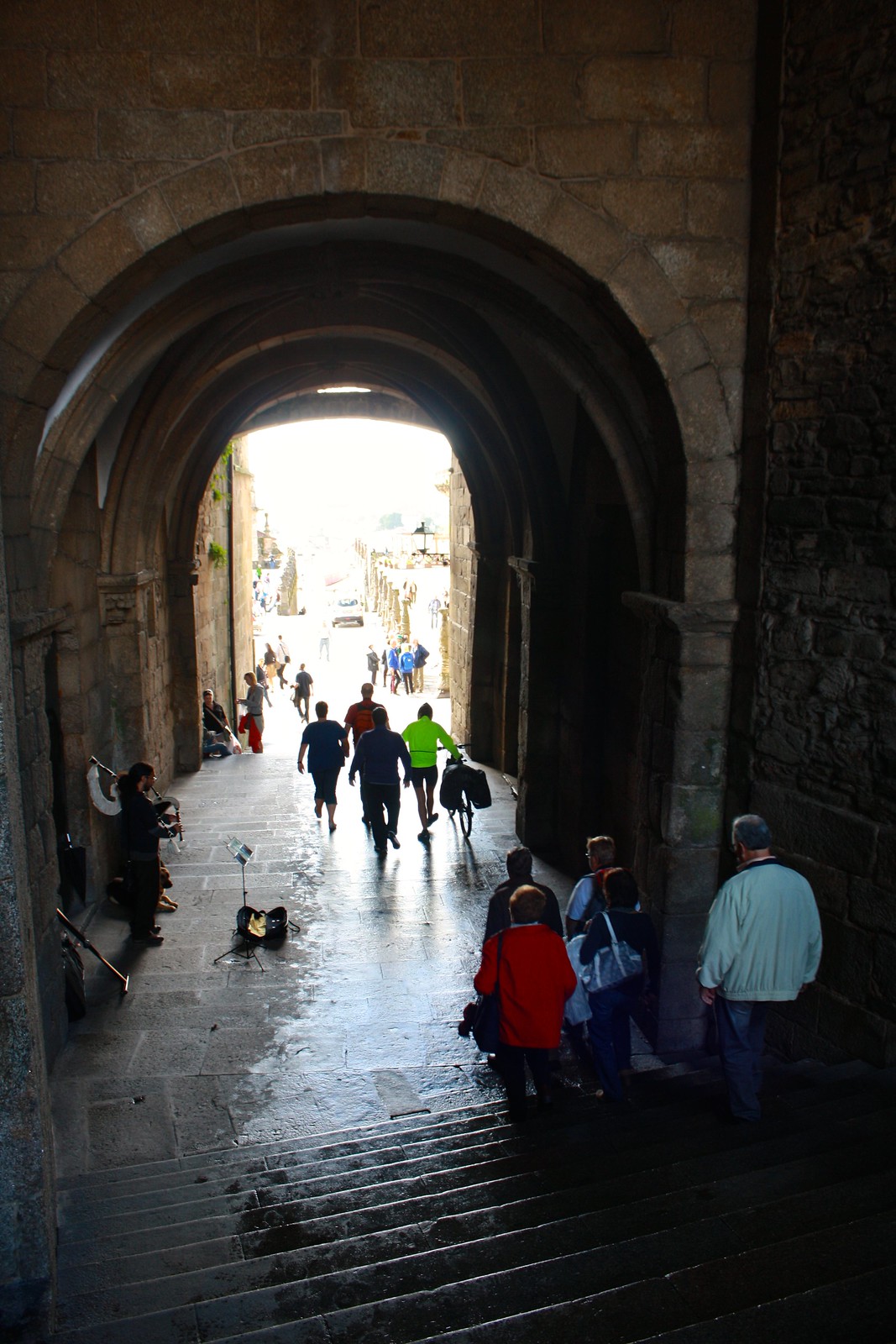 |
| The passageway leading into Praza do Obradoiro |
The cathedral we can see today is actually the third such church to occupy the purported burial ground of St. James. Constructed in the austere Romanesque style between 1075 and 1211, grand Gothic cloisters were later built to the south and an over-the-top remodeling left almost no corner untouched during the Baroque era. There’s a lot going on here, from façades and side-chapels to palaces and bell towers, so I’ve put together a guided tour that will take you all around the exterior of the cathedral and then in a similar circuit inside the church.
The tour starts at Praza do Obradoiro, the largest and grandest square in Santiago, just west of the cathedral. Go down a tunnel-like passageway, where there are often bagpipe players performing traditional Galician music, and head for the center of the plaza.
Praza do Obradoiro (west façade)
 |
| Praza do Obradoiro |
Once you’re oriented in the plaza, look around for a few minutes and simply take in the views, as they’re some of the best in the country. When the cathedral was being built, the obradoiro or workshop would have been set up along the hill in front of the church and was where stonemasons would have prepared huge blocks of granite or carved sculptures. Although the workshop has been dismantled for 800 years, the name stuck. Today, tourists frustrated with the rain mingle here with pilgrims joyously celebrating the end of their journey. Biking groups line up side-by-side while those who came on foot simply lie down in exhaustion.
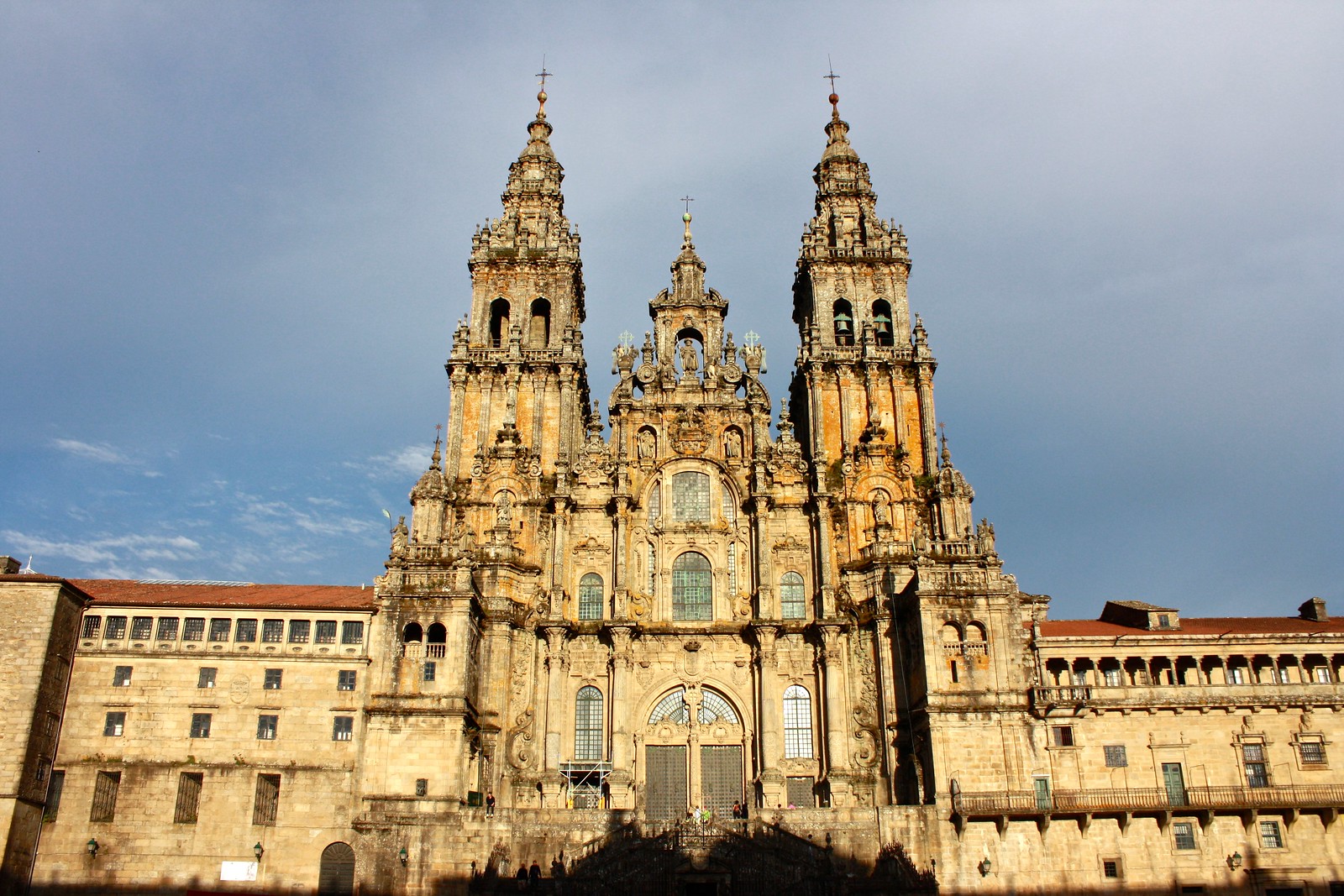 |
| Obradoiro façade |
Look up at the cathedral. The church’s west façade is one of the most beautiful in the country, if not all of Europe, and is featured on the obverse of Spain’s one-, two-, and five-cent Euro coins. This exuberant façade would be unrecognizable to Europeans from the Middle Ages, however, as it completely substituted the earlier one that was designed when the cathedral was built.
Architect Fernando de Casas y Novoa was commissioned to beautify the medieval westwork in the 1700s, and he went about creating a Baroque façade full of swooping curves, swirling flowers and vines, and in general way too much ornamentation. This was not only to get with the times (the Baroque style was “in” then), but also to finish the work begun a century earlier that had raised the height of the towers; to enclose the Pórtico da Gloria, a medieval sculpture ensemble that had been left to deteriorate in the humid air; and to emphasize the veneration of St. James. As the cathedral (and the city) were built on a bluff between two rivers, a lovely double staircase takes you from the plaza up to “ground level” where the main doors are.
To the left sits the Pazo de Xelmírez, the archbishop’s palace and one of the few remaining examples of civil Romanesque architecture. The outside is rather boring, but when the cathedral museum puts on temporary exhibitions, you can go inside and explore kitchens and dining halls with sculptures that depict medieval food and cooking.
 |
| Hostal dos Reis Católicos |
Now, turn to your left. You’re facing the Hostal dos Reis Católicos, the “Catholic Monarchs’ Hotel,” which today is Santiago’s Parador or fancy state-run hotel. When Ferdinand and Isabella (a.k.a. the Catholic Monarchs) came to Santiago in 1492, they were appalled at the lack of facilities for pilgrims who had finished the Camino, many of whom who were sick or injured. To rectify the situation, they ordered the construction of a catch-all pilgrim hostel and hospital with a chapel and two stately Renaissance-style patios. The hospital later doubled in size in the Baroque era, but the Plateresque triumphal arch that guards the entrance remains the most impressive part of the monument: it’s just dripping with saints and pointy towers and flanked on either side by the coats of arms of Ferdinand and Isabella. Well into the 20th century it was still Santiago’s main hospital.
 |
| Pazo de Raxoi |
Turn left again to the Pazo de Raxoi, the “Raxoi Palace,” which today is the Casa do Concello or Santiago’s town hall. Archbishop Raxoi ordered it to be built in 1766 and had French engineer Charles Lemaur design it in the Neoclassical style, so pointy pediments and Ionic-order columns abound. An arcaded covered walkway spans the entire width of the building—a useful feature in rainy Galicia—and at the top there’s a bas-relief sculpture that depicts the legendary Battle of Clavijo in which Santiago came to help the Christians as they fought against the Moors.
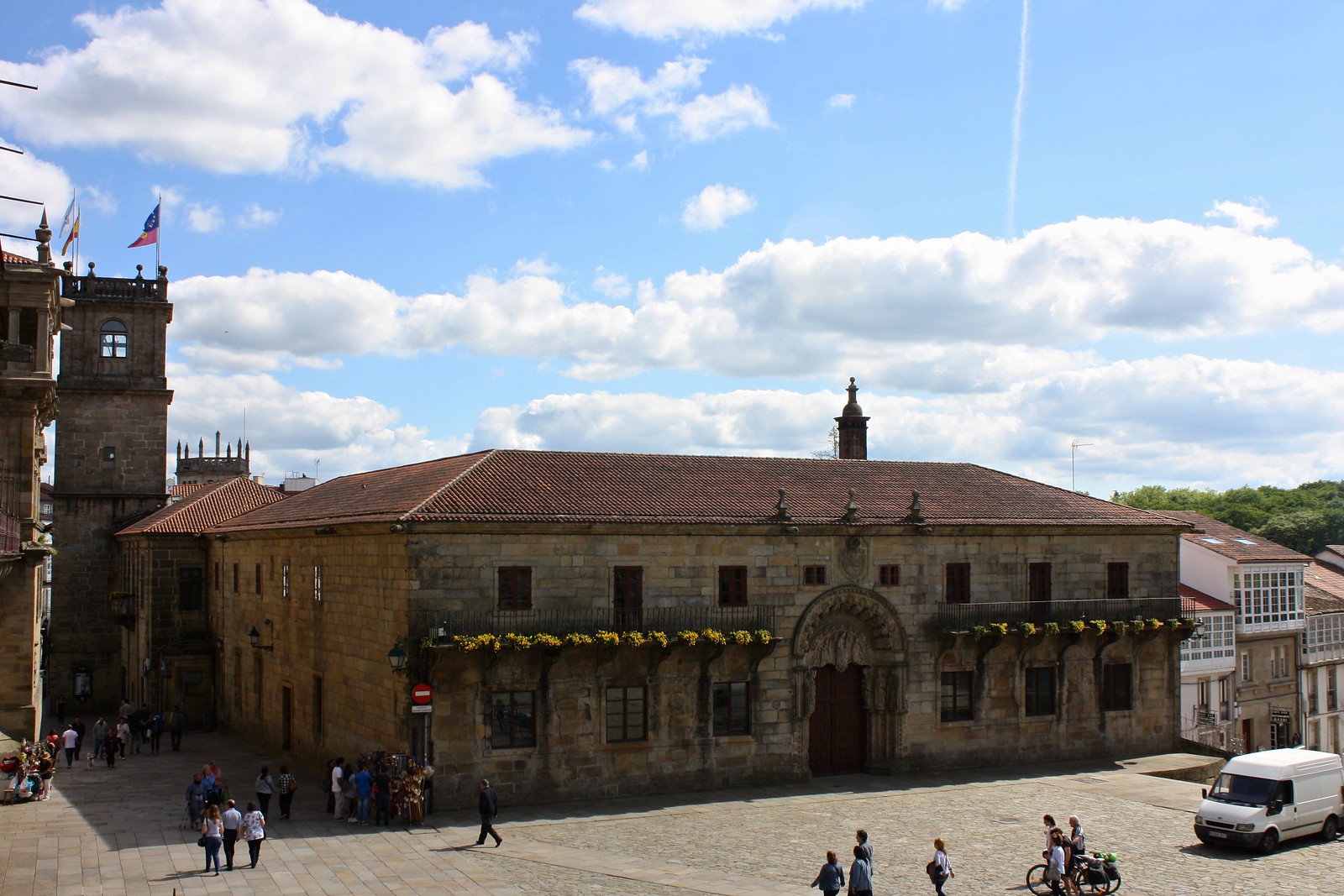 |
| Colexio de San Xerome |
On the southern end of this plaza is the Colexio de San Xerome, with its pretty sculpted Romanesque-Gothic portal that was rescued from a former school. Today, it houses the office of the university’s vice-chancellor. Further south is the flag-bedecked tower of the Colexio de Fonseca, which is where Santiago’s university originated in the 1500s.
Now, let’s begin our counter-clockwise circuit around the cathedral, leaving the Praza do Obradoiro at the south end and turning down Rúa de Fonseca.
Praza das Praterías (south façade)
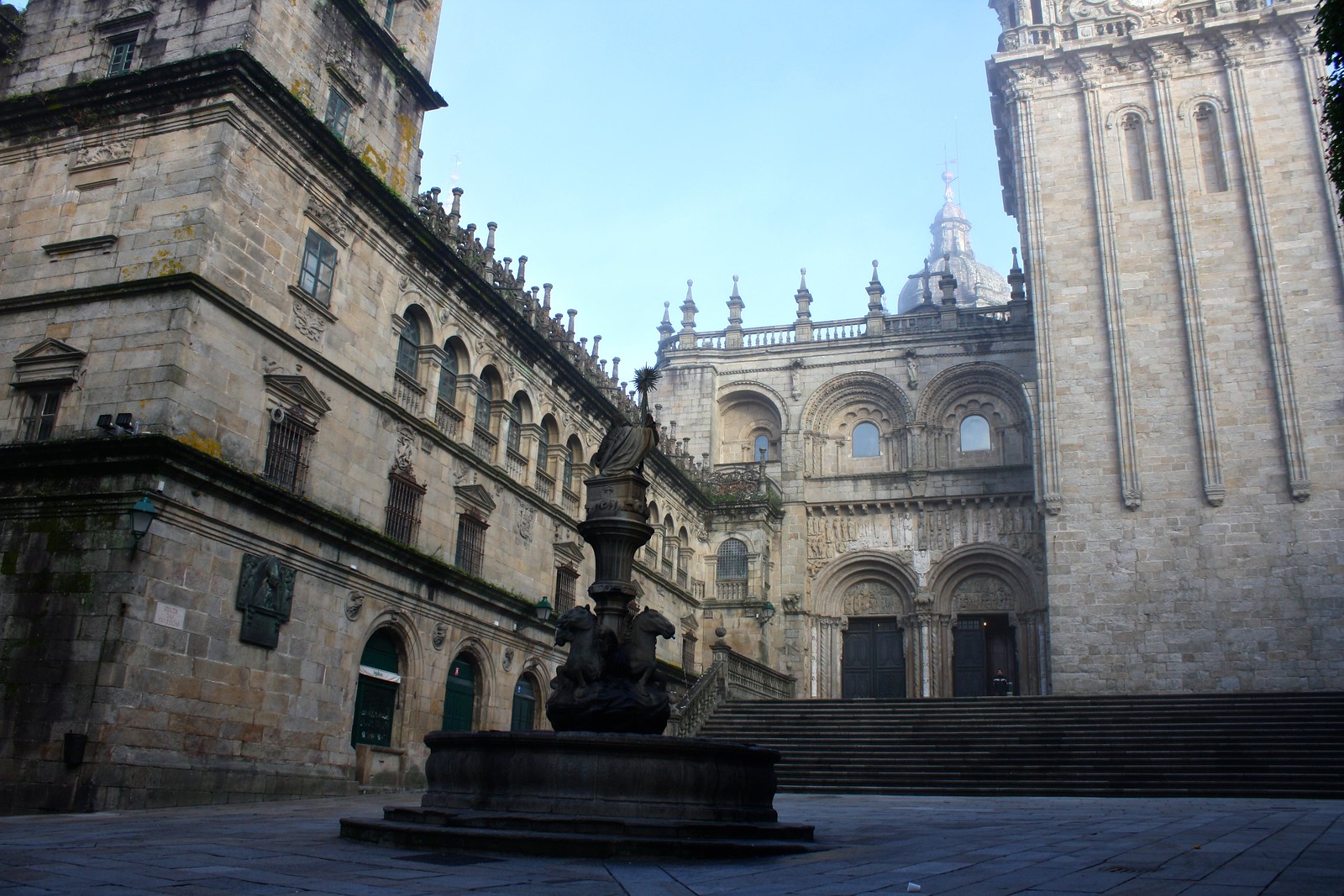 |
| Praza das Praterías |
After tracing the southern edge of the cloisters’ imposing foundations, we reach the square that was named for the silversmiths’ guild (praterías), and, even today, you can find shops in this plaza selling all sorts of silver-crafted goodies.
 |
| South façade |
The cathedral’s façade that you can see from the Praza das Praterías is the church’s oldest and the only Romanesque façade that appears as it did eight centuries ago. A double portal supports carved marble columns, sculpted tympanums, and an upper frieze that is decorated in a rather haphazard manner.
Pass over the cloister walls and silver shops and turn south to the Casa do Cabido, the cathedral’s chapter house that was built in 1759 for the sole purpose of beautifying the plaza. This building with pretty red doors and windows is only three meters deep—pure façade. Gotta love the Baroque era!
 |
| Praza das Praterías |
Just down the street, along Rúa do Vilar, is the Casa do Deán, the former Pilgrims’ Office where people would go to get their compostela or certificate that says they have completed the Camino de Santiago. (It has since moved across town.)
On the square’s east edge you can visit the Museo das Peregrinacións e de Santiago, a fresh, new museum with a scale model of the entire cathedral plus a model of what the walled city of Santiago would have looked like in the Middle Ages.
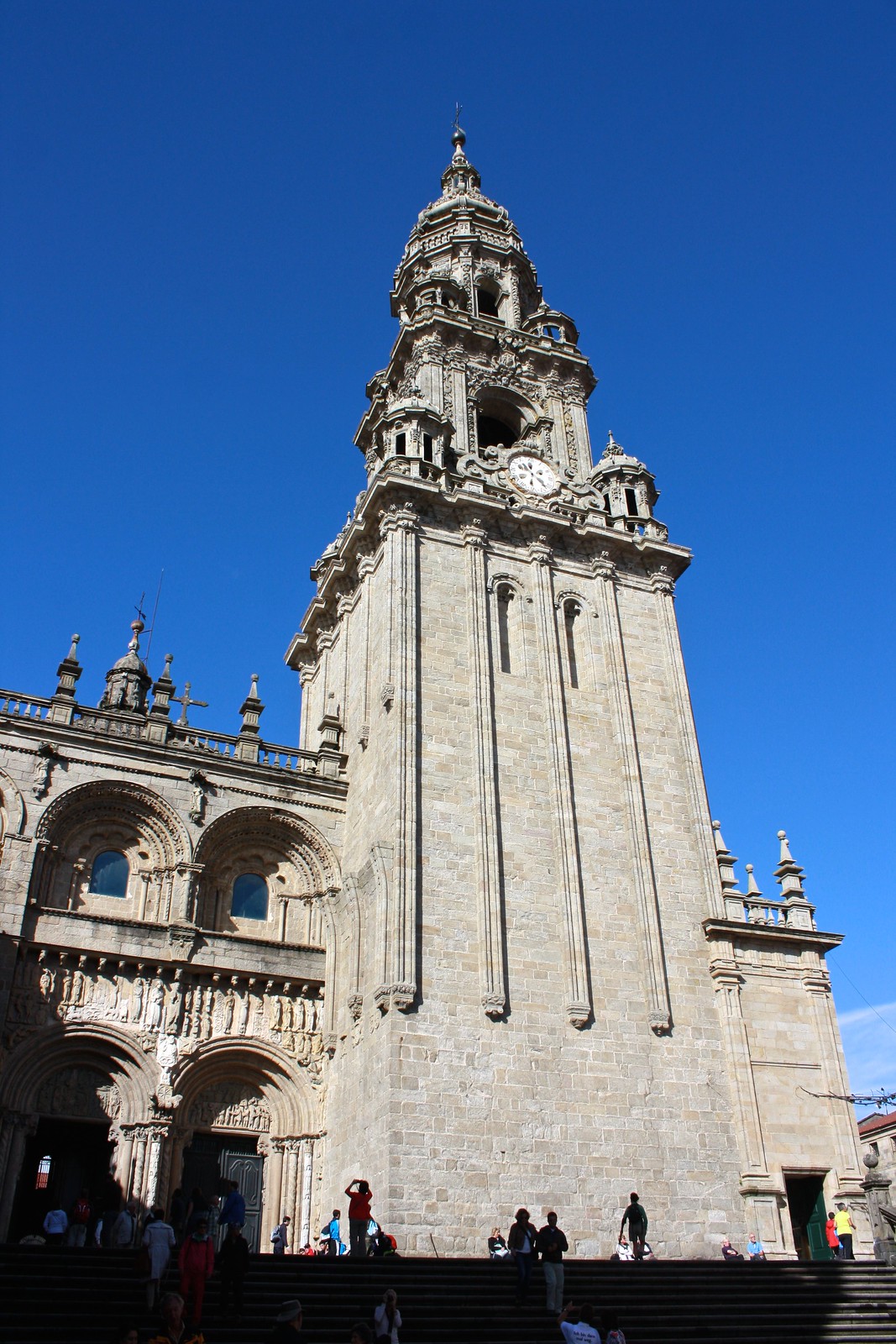 |
| Clock tower |
Finally, the clock tower. Its base was built in the 1400s but the upper section was remodeled in (you guessed it) the Baroque style in 1680 by architect Domingo de Andrade. In my opinion, it’s the cathedral’s prettiest tower and makes for some really nice photos when framed by houses along Rúa do Vilar or Rúa do Franco. Every quarter of an hour, the clock tower’s bells ring out the time with pleasant, deep chimes.
Go up the stairs and follow the clock tower northeast, where a huge square opens up.
Praza da Quintana (east façade)
 |
| Praza da Quintana |
This plaza takes its name from the quintana or burial ground that used to occupy this space until 1780, when the city’s public cemetery was moved outside the old town. Accordingly, the square is divided into Quintana de Vivos (“Quintana of the Living”) above the stairs and Quintana de Mortos (“Quintana of the Dead”), which takes up the greater part of the plaza and was where a huge necropolis was discovered in excavations carried out in 1964.
Praza da Quintana is dominated by the huge western wall of the Convent of San Paio de Antealtares, broken up by windows that, although covered in wrought-iron grating, hold flower planters that add color to an otherwise ascetic façade. Founded a thousand years ago as a monastery to look after St. James’ tomb (hence the name Antealtares or “behind the altar”), Benedictine nuns moved in after their Benedictine brothers moved out in 1499.
Domingo de Andrade, the same architect responsible for designing the cathedral’s clock tower, was also the main man who shaped the other three sides of this grand city square. The three walls that zig-zag across the cathedral’s east façade were put together to give a uniform look and feel to this side of the church, since it had become a helter-skelter collection of side-chapels bubbling out from the transept and apse.
 |
| Praza da Quintana |
It may not be typical for churches to have an entrance at the back of the building, but this cathedral does: the Porta Santa or “Holy Door,” a decorated passageway that leads straight to Santiago’s crypt and which is only opened during Holy Years, when July 25th (St. James’ feast day) falls on a Sunday. When the original Romanesque stone choir was taken out of the cathedral, many of the sculptures that had adorned the stalls were repurposed here around the Holy Door.
On the southern end of the plaza there’s the Casa da Conga, originally intended to be a residence for cathedral canons (the name conga doesn’t refer to the conga dance), is a quartet of stately Baroque houses that cafés, bars, and restaurants call home today.
The Casa da Parra closes out the plaza to the north. Called the “Vine House” because of the sculptures that decorate the exterior, its lower and upper doors are framed by heavy bunches of stone grapes.
To continue the tour, walk up the stairs to the “Quintana de Vivos” and head to the left of the Casa da Parra down a narrow walkway to get to the next square.
Praza da Inmaculada (north façade)
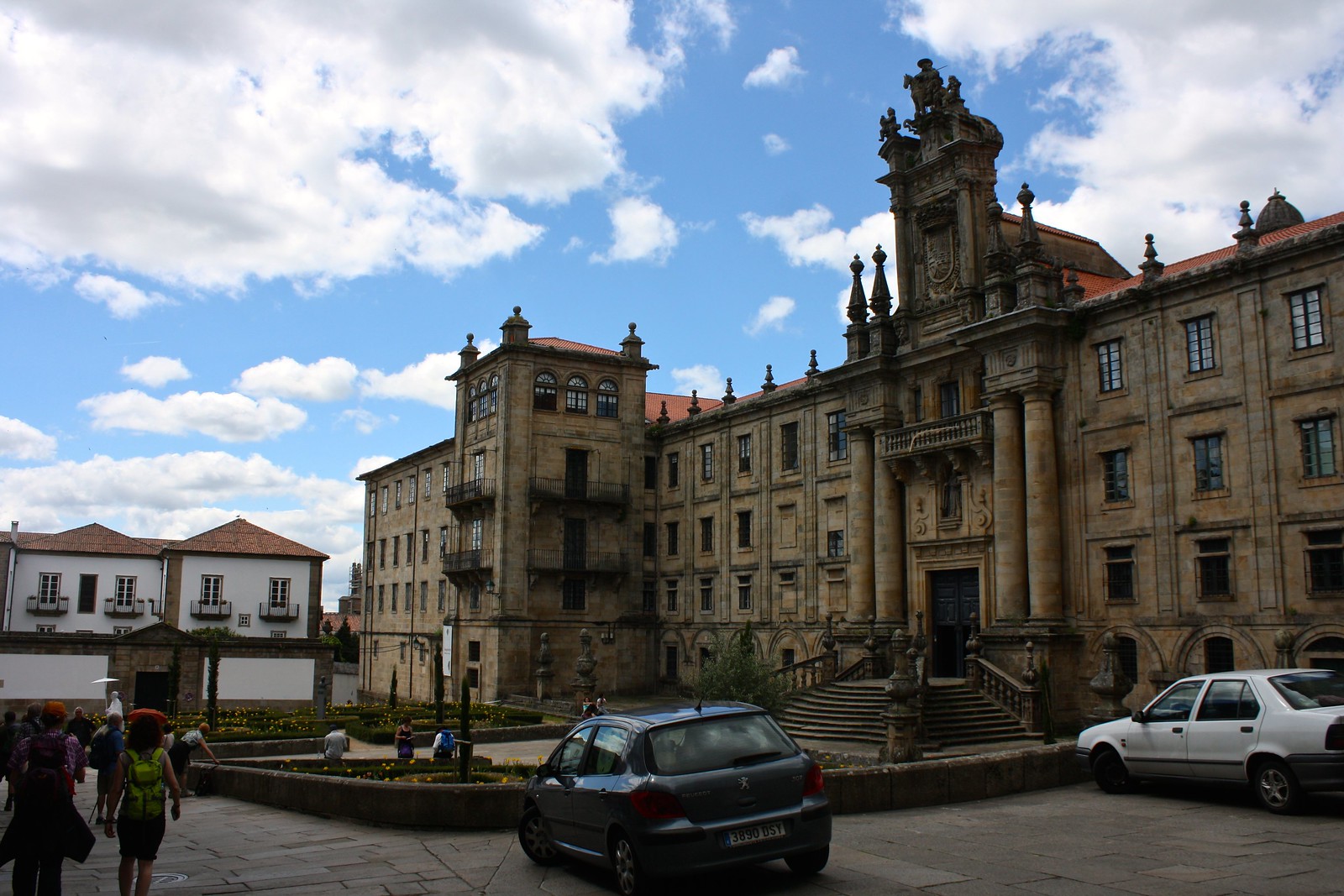 |
| Praza da Inmaculada |
The Praza da Inmaculada (“Immaculate [Conception of Mary] Square”) marks our final stop as we circle around the cathedral. This is the final stop along the Camino de Santiago for pilgrims hiking the camino francés—the “French Way” that begins in the Pyrenees in southern France—and the camino inglés—the “English Way” that starts to the north on the coast. All medieval pilgrims would have entered the church here at the north façade, called the Porta do Paraíso or “Paradise Portal.” Tragically, its original Romanesque sculptures were destroyed when the present Baroque-Neoclassical façade was constructed in the 1700s.
The north entrance is also called the Azibechería façade because shops nearby sell jewelry made from azibeche or jet, a black gemstone.
 |
| Azibechería façade |
Facing the Azibechería entrance looms the huge former monastery of San Martiño Pinario, once the second-largest monastery in all of Spain. Today, it houses the Seminario Mayor (seminary for Catholic priests) and an hospedería or simple hotel for pilgrims and tourists alike.
As the doors to the church in Praza do Obradoiro are usually closed, enter the cathedral here now.
The inside
Once you step inside the cathedral, you’ll most likely be shocked at how very different the interior is from the outside; that’s because most of the façades were reworked seven centuries after the church’s construction. When ground was first broken in 1075, the Romanesque style was all the rage in medieval Europe: drawing on the ruins and memories of the now-fallen Roman Empire, architects made palaces and churches that weren’t quite Roman, but Roman-esque. Semicircular arches are everywhere, and heavy barrel-vaulted ceilings (supported by such arches) required the load-bearing walls to be thick and sturdy. Because of this, Romanesque churches are often dark and gloomy as the windows could only be “punched-out” small slivers, lest the walls buckle and fall.Santiago’s cathedral was also designed with pilgrims in mind, already numbering in the thousands back then and who made for a very crowded Mass. Following the layout of similar pilgrimage churches, architects extended the aisles on either side of the main nave where worshippers gather and wrapped them all the way around the apse, the east end behind the altar. In this way pilgrims could (and still do) freely walk around the entire church without interrupting religious services.
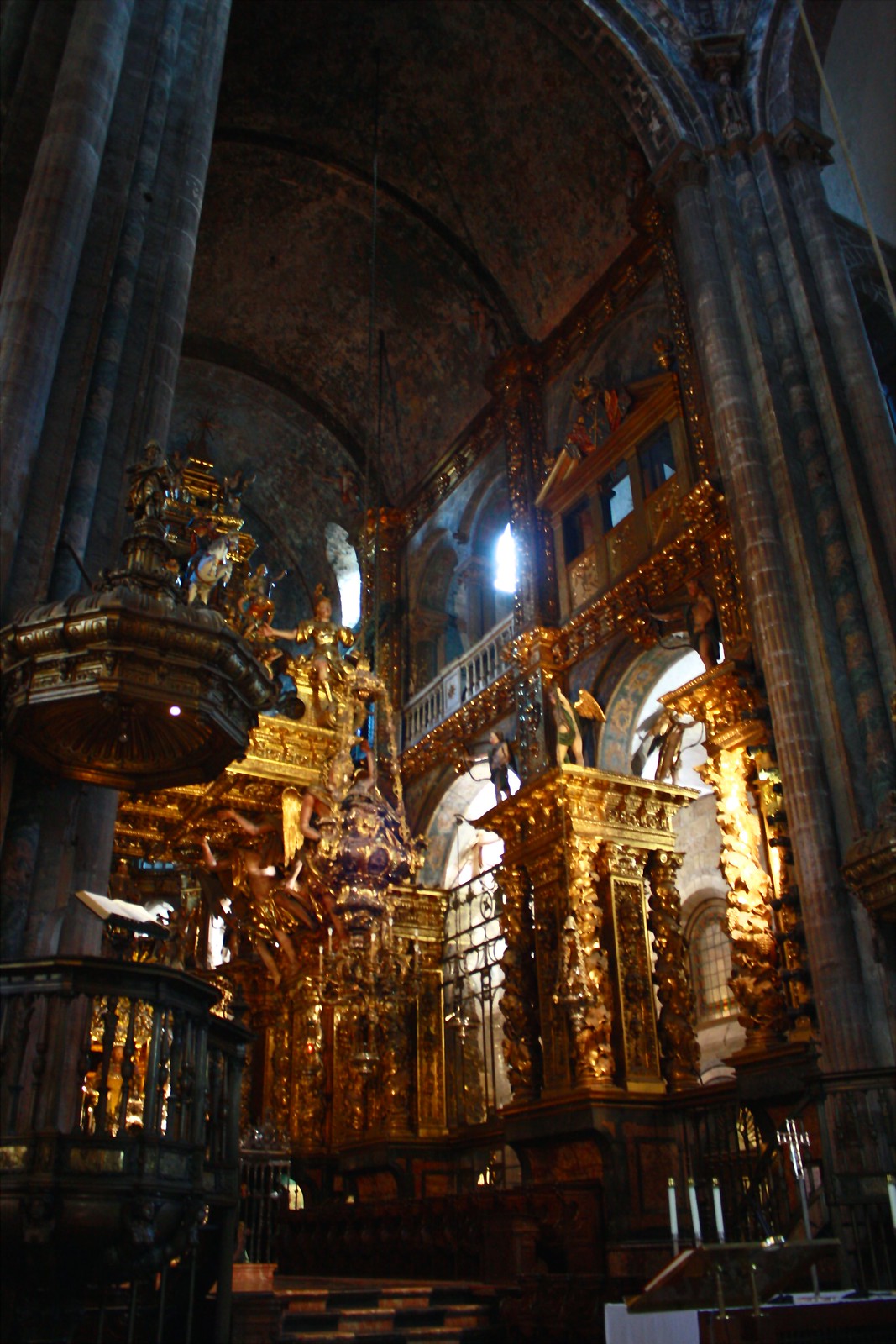 |
| High altar |
The cathedral’s high altar is Baroque to the extreme. Designed to dazzle and awe the viewer, a baldacchino or ceremonial canopy covers the crypt and is completely covered in gold leaf. This weighty structure appears to be held up on the shoulders of angels, and wildly-gyrating Solomonic columns twirl around as grapevines twist up their sides. The Four Virtues gracefully crown the altar, and all three representations of St. James can be found: at the top, mounted on a white horse is Santiago Matamoros, St. James the Moor-Slayer, who came to assist the Christians against the Moors in the legendary Battle of Clavijo; in the center is Santiago Peregrino, dressed in traditional pilgrim garb with brown robes, a wide-brimmed hat, and a walking staff with a bottle gourd; and peeking out of a tiny room decorated to the extreme with silver and gold is Santiago Apóstol, the Apostle James.
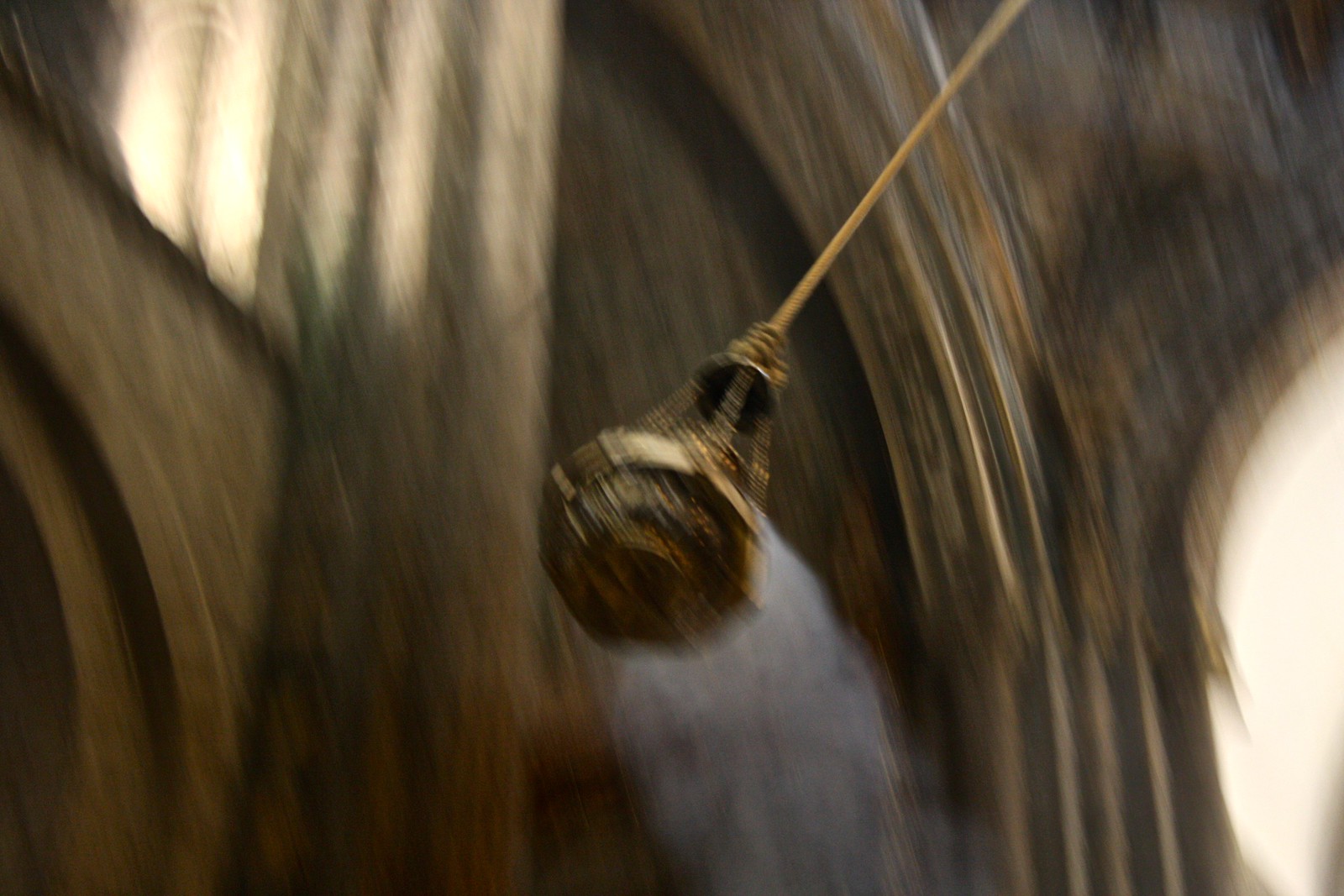 |
| The botafumeiro in action |
If you’re lucky, the botafumeiro will be hanging from the ceiling. This larger-than-life silver censer is used to burn incense during Mass—swung at 68 km/h (40 mph) from one end of the transept to the other. Today, it fills the cathedral with a heavenly, woody fragrance, but in the Middle Ages, it was all the Church could do to cover up the stench of the sweaty, unbathed hordes of pilgrims. It’s most often swung during the noon pilgrim Mass and for special occasions, but ask below in the welcome center to know for sure.
Now, turn right and head down the north aisle of the cathedral, passing the round, Parthenon-style Comunión Chapel and the smaller Santo Cristo de Burgos Chapel.
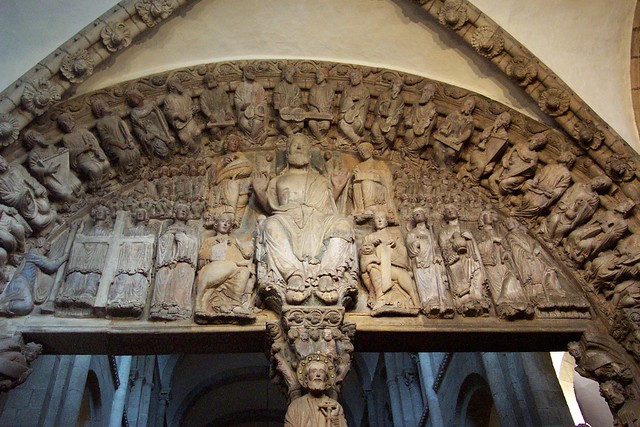 |
| (Source: Eduardo Rodríguez Recio) |
You’ve arrived at the Pórtico da Gloria, the Glory Portico, considered the finest example of medieval sculpture anywhere. Depicting an iconographic theme from the Book of Revelation, in the central tympanum Christ sits on the throne. See his hands, his feet, his side. The Four Evangelists with their scrolls (the four Gospels) frame Jesus, two angels come bearing his cross, and the 24 Elders worship him playing medieval instruments.
Beneath Jesus’ feet sits St. James. It was a pilgrim tradition to place their hands on the column he rests upon, and you can see the indentations left by millions of pilgrims over the centuries. On the other side, there’s a statue of Maestro Mateo, the master builder responsible for designing the Glory Portico, and it was also tradition to bump heads with his likeness after finishing the Camino…to receive part of his genius. In order to preserve the medieval sculptures, they are both fenced off today.
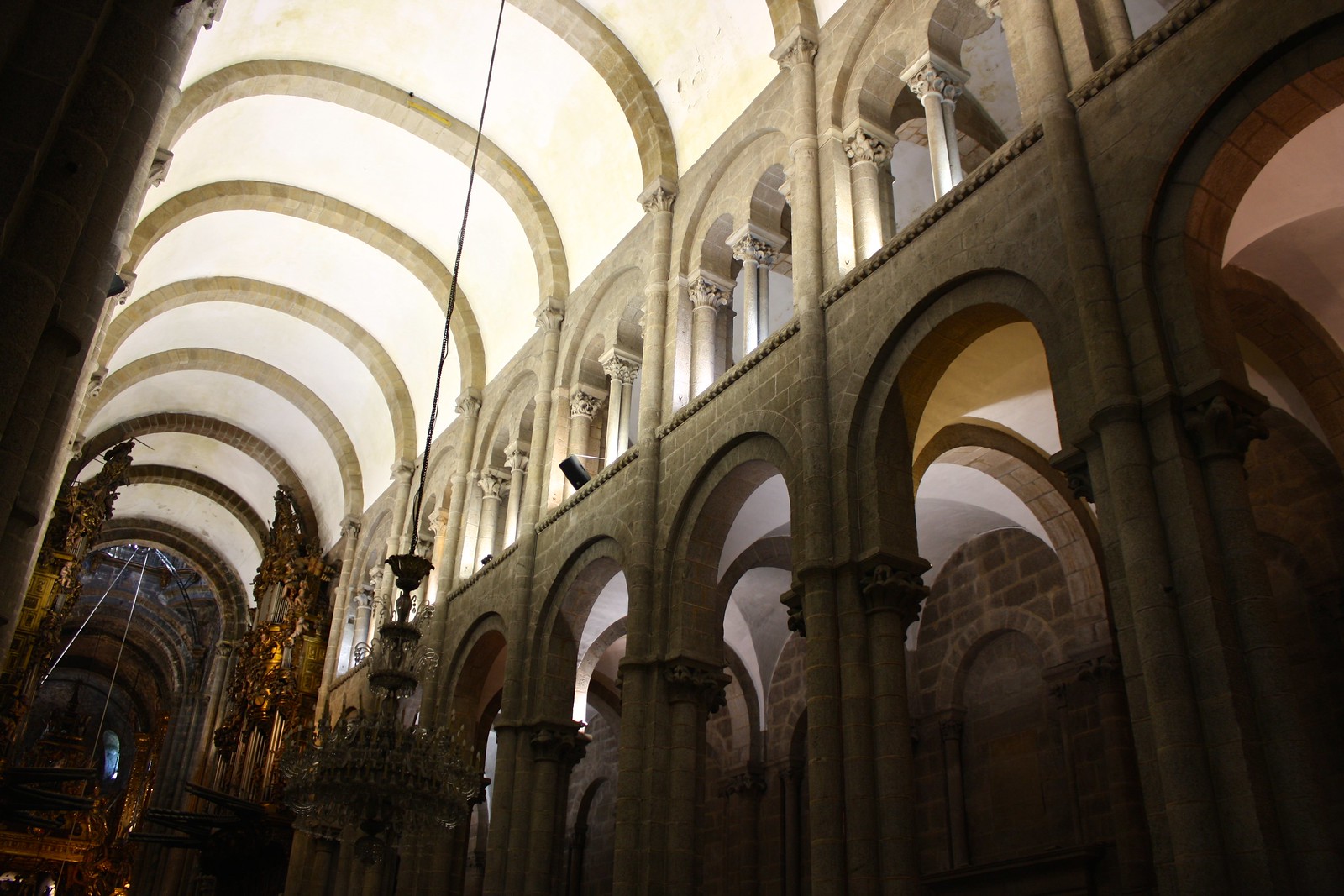 |
| Barrel vaulting in the main nave |
Step out from beneath the Glory Portico and enter the central nave. Barrel vaults create a simple, pleasing ceiling—another manifestation of that round Romanesque arch. The upper level, or triforium, is a continuous gallery that wraps around the entire perimeter of the church, and was where medieval pilgrims would sleep before Mass the next morning.
The interior may appear dark and shadowy, even depressingly so, but this would not have been the case right after the cathedral was finished. Eight centuries ago the church would have been filled with light streaming in from tall windows that lined both sides of the main nave. Unfortunately, the Gothic cloisters required the windows on the south side to be bricked up, and the two chapels on the north side naturally blocked out a few windows each. Thankfully we have electrical lighting today, and windows in the upper level continue to let in some sunlight.
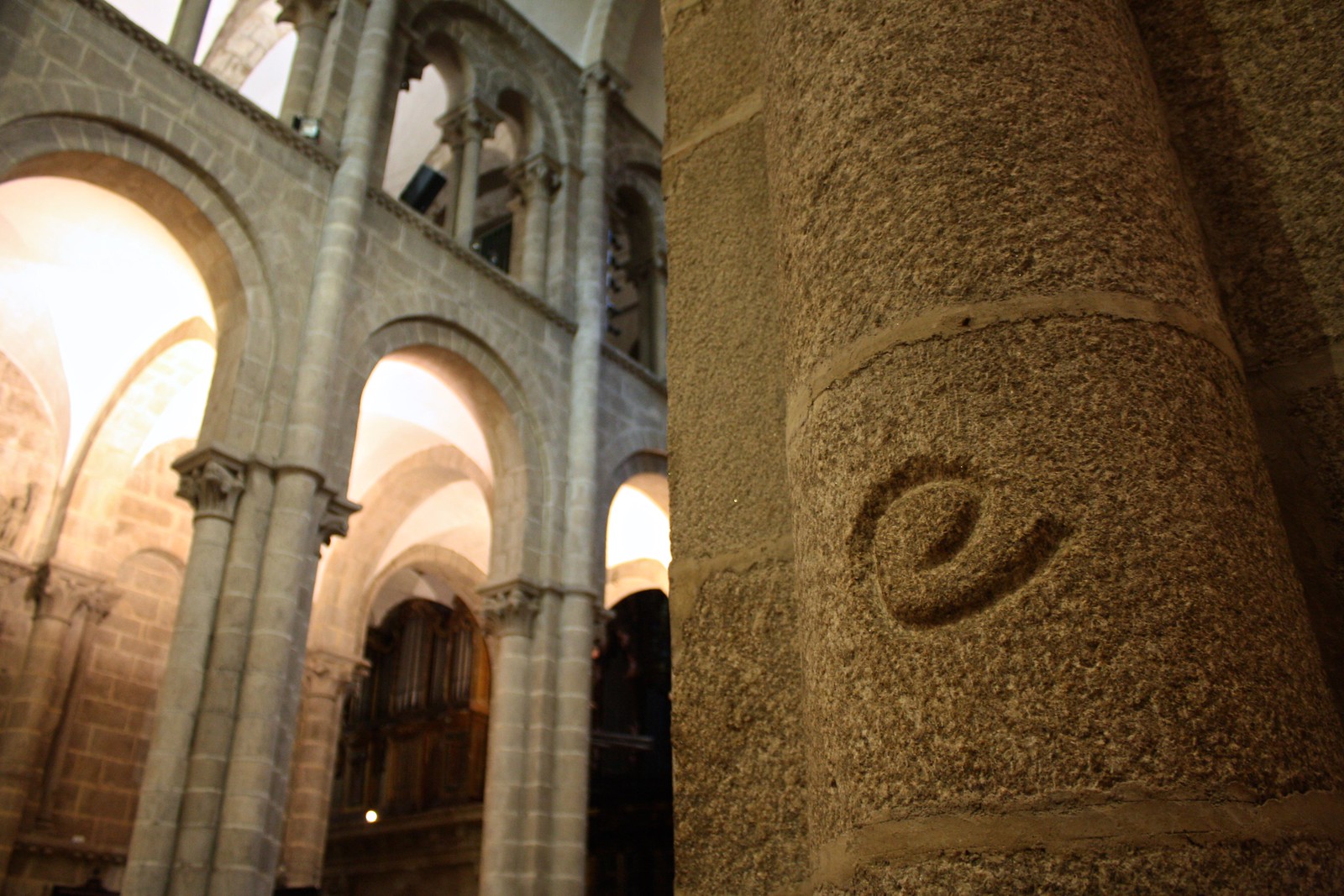 |
| Stonemason mark on a pillar |
Let’s continue our tour of the inside and begin walking up the south aisle. As you make your way back to the altar, keep an eye out for the little marks left by stonemasons on the granite blocks of the pillars and walls—sort of like branding cows, but for stones.
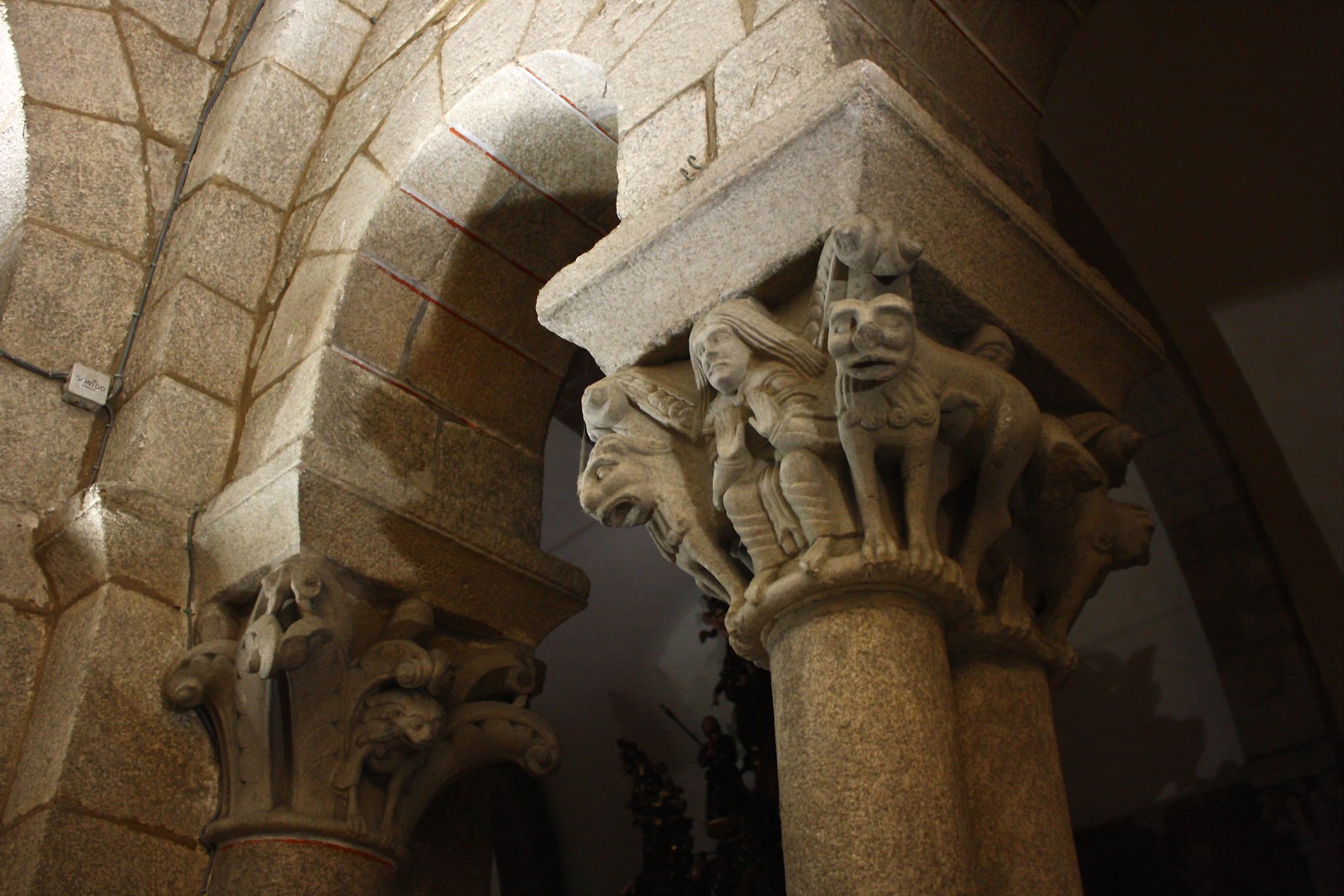 |
| Sculpted column capitals |
And don’t forget to look up! The capitals that cap off columns in Romanesque-style churches are always fascinating because rarely are any two alike. Unlike the predictable classical orders of ancient Greece and Rome, Romanesque column capitals are creative and unique: sometimes a simplified version of a Corinthian capital, other times the wide “banana leaf” style, but most often they are sculpted to represent animals, angels, demons, or scenes from the life of Christ. Remember, in the Middle Ages when most parishioners were illiterate, the church building itself acted as a “poor man’s Bible” and illustrated passages from the Good Book.
 |
| Chapel of Nosa Señora do Pilar |
Walking past the altar again you’ll see on your right the Chapel of Nosa Señora do Pilar (“Our Lady of the Pillar”), dedicated to the legendary apparition of the Virgin Mary to St. James while he evangelized in Roman Hispania. Decorated to the extreme in the glop-glop-gloppy Baroque style, this chapel features a dozen or so scallop shells (the symbol of the Camino and of Santiago) plus the red, sword-shaped cross of St. James.
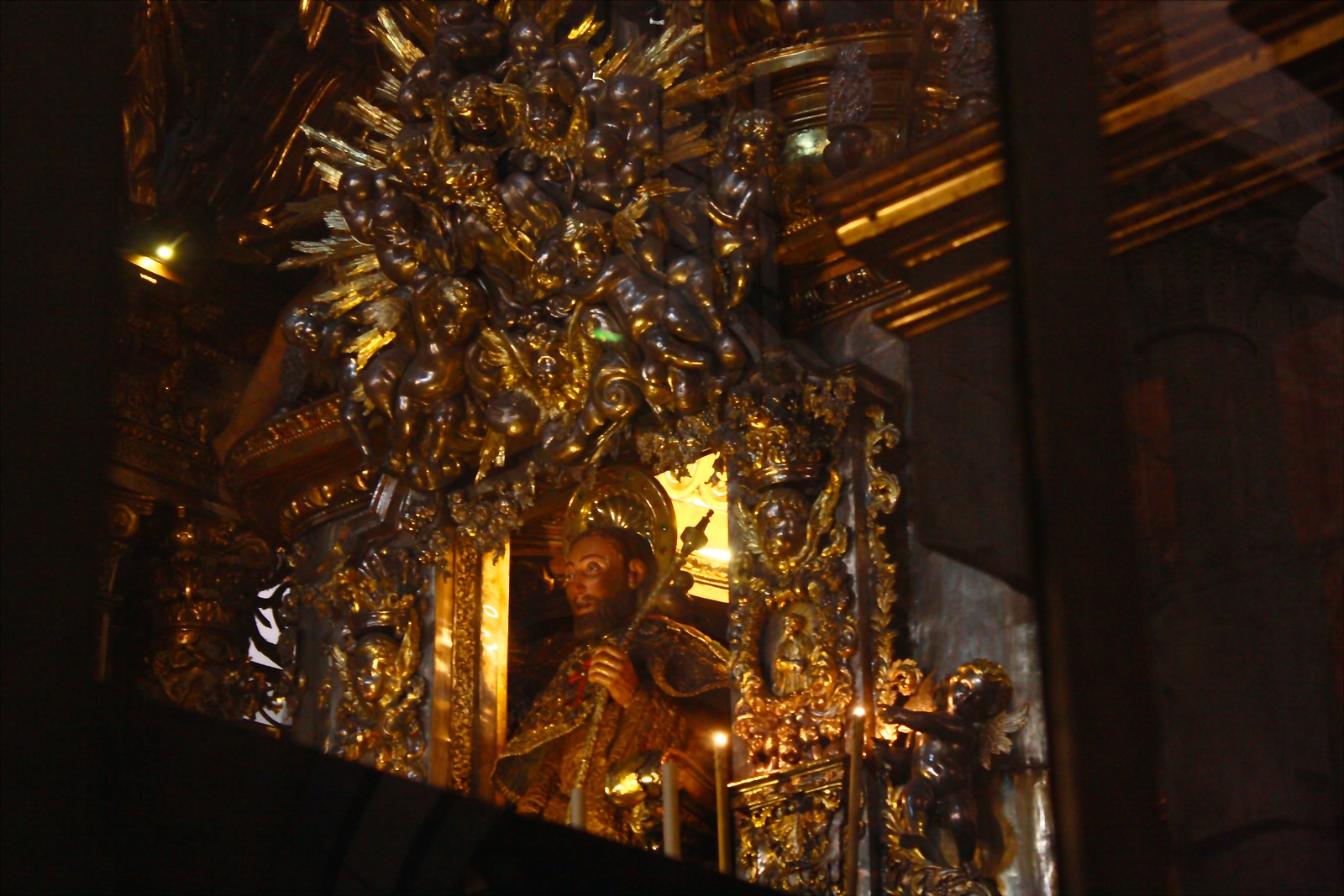 |
| Statue of St. James |
Now, walk through the ambulatory until you can find the waiting line to embrace the Apostle. It’s another pilgrim tradition to climb up the stairs into the camarín or tiny room behind the altar that houses a medieval statue of St. James…and then give that statue a hug. Whether you hug or not, it’s still a really beautiful piece of Baroque art and offers a unique perspective of the cathedral. Walk down the steps and turn left toward the entrance to the “SEPULCRUM SANCTI JACOBI GLORIOSUM”
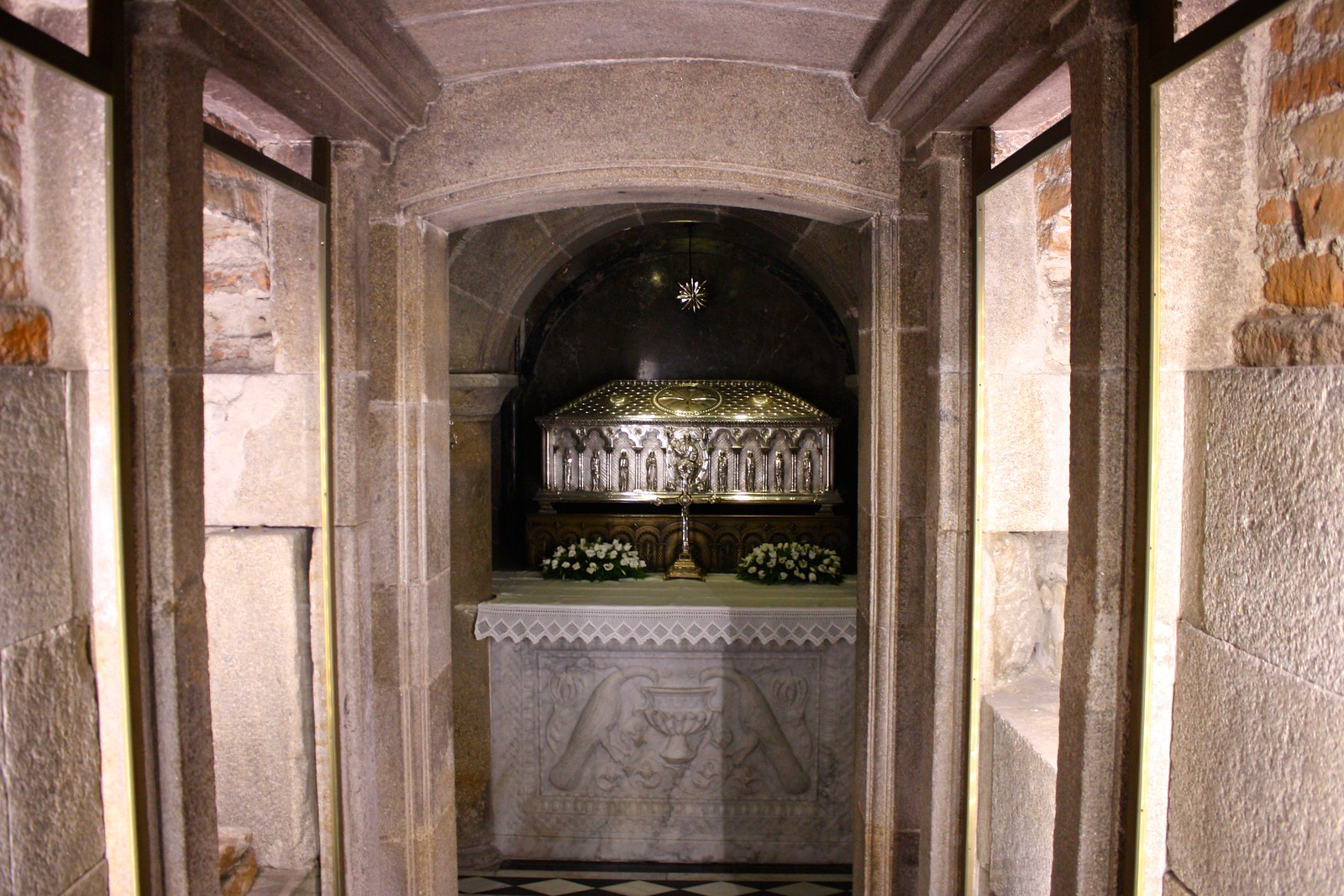 |
| The crypt |
You’ve finally reached the crypt of St. James, which is purported to contain the relics of the saint that the cathedral (and the city) were built around. Whether the true remains of St. James are actually inside the silver urn is a topic for another blog post, but for now, just ponder the significance that this would have had for medieval Christians, who went on pilgrimage in hopes that Santiago would work miracles for them or heal an illness. Pope Leo XIII officially declared the authenticity of the relics in 1884.
Exit the crypt on the other side and make your away around the apse, which is packed to the brim with side-chapels. Only five would have originally budded out from the apse, with two more on each arm of the transept, for a total of nine side-chapels. Over the years, some were torn down to make way for bigger chapels, some were expanded and re-decorated, and even the empty space between them was filled in. You can see the other side of the Holy Door here, a 2003 bronze sculpture that depicts the life and death of St. James, and which was last opened in 2010, the most recent Holy Year.
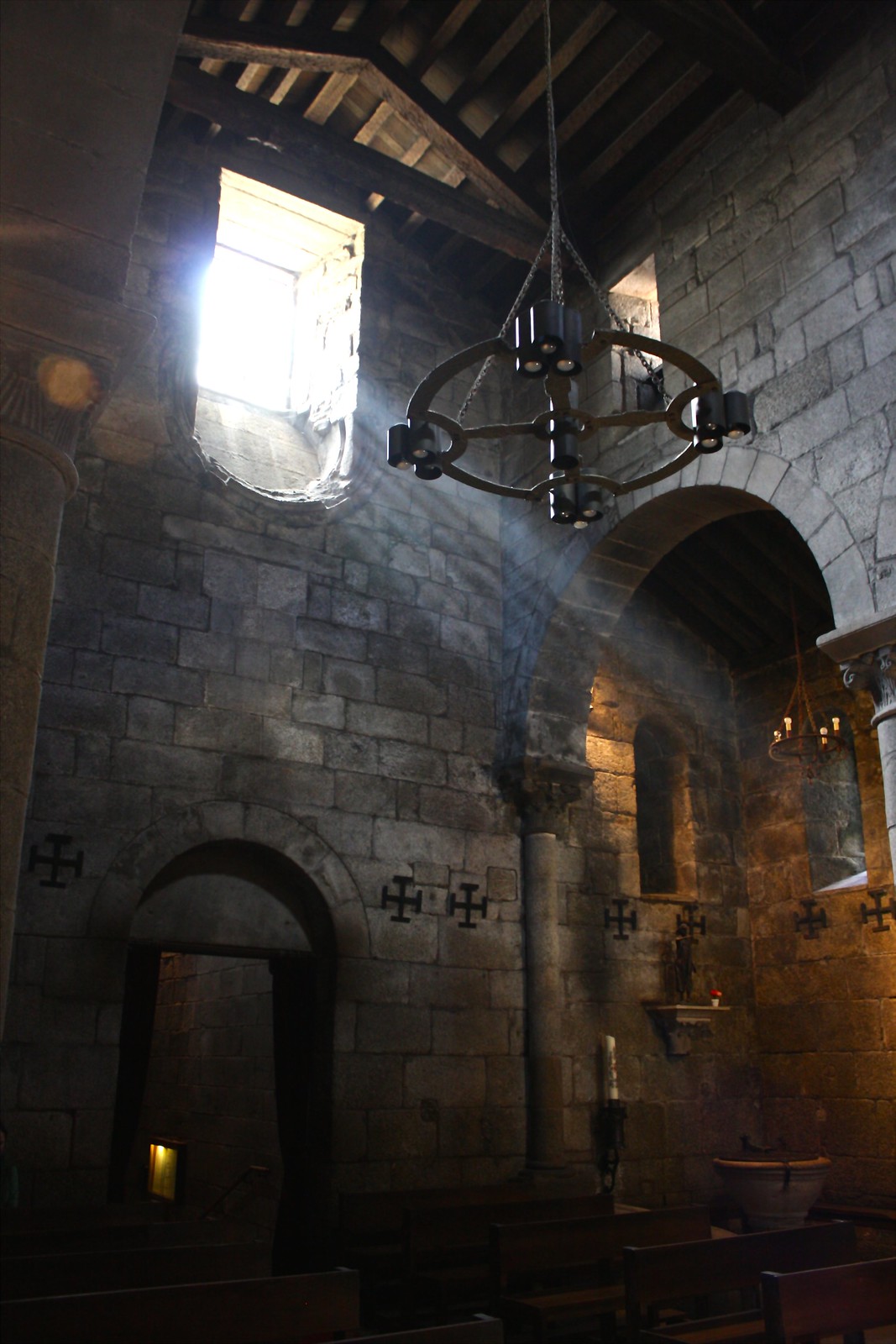 |
| Church of Santa María a Antiga da Corticela |
We’re almost at the end of the tour, so once you reach the altar again, turn right toward the doors you came in through. But before you leave, veer to the right and see if you can peek in to my favorite little corner of the cathedral: the Church of Santa María a Antiga da Corticela. Originally an independent church that was built around the same time as the cathedral, it has since been absorbed into the fabric of the cathedral, accessible via a granite passageway. Dark and moody, the Corticela Church gives you an idea of what a Romanesque church would have been like in the 1200s: huge, massive walls and columns bear the weight of the structure, wooden beams support the roof, and tiny slits let in sparse sunlight. In the tympanum just above the entrance, there’s a nice sculpture group depicting the Adoration of the Magi, crafted in the same style as the Glory Portico.
The tour ends outside in the Praza da Inmaculada; to get back to the main Obradoiro square just head down the tunnel to the left where there are probably street performers playing bagpipes or singing opera.
More things to explore
 |
| Cloisters |
This tour may be over, but there is still so much more left to explore! It’s really nice that most of the cathedral is open to the public for free all day long, but the foundation that manages the church complex offers half a dozen different tours you can go on that take you all around the cathedral.
Most of the guided tours include access to the cathedral museum, which contains cool artifacts and religious art as well as a reproduction of the original stone choir stalls that would have stood in the central nave. As part of the museum, you can check out the Gothic-era cloisters that guard the Fons Mirabilis, a huge Romanesque fountain that would have stood in the modern Praza da Inmaculada and served as a ritual bathing site for stinky pilgrims.
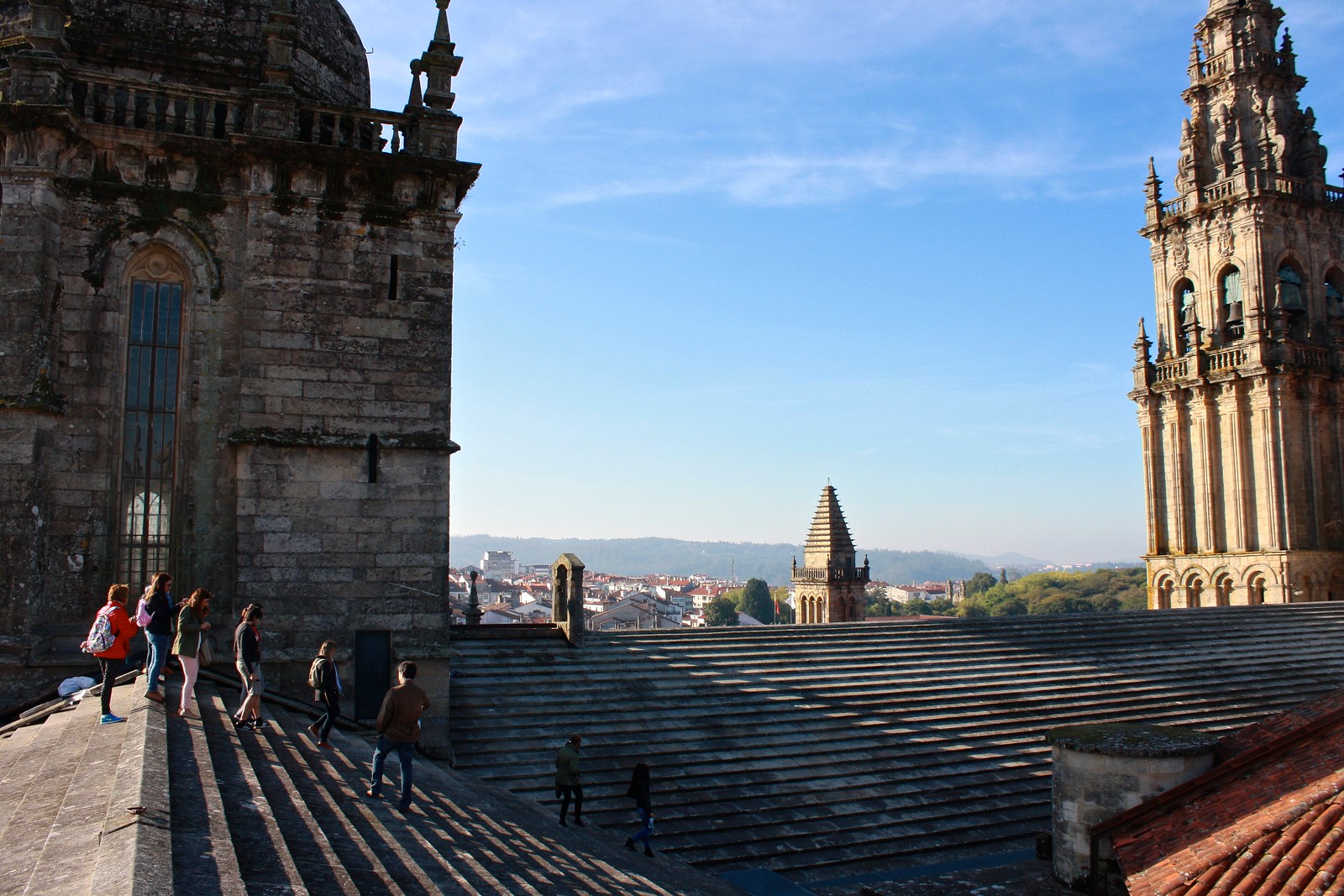 |
| The cubiertas or roof |
My favorite activity that you can do is go up to the top of the cathedral and explore the granite rooftop. Not only does it let you check out what is typically an off-limits place for most churches, but it also gives you a unique perspective of the four surrounding plazas. If you do anything on this list, go on the roof tour.
 |
| View of the transept from the tribuna |
A few weeks ago, I went on a tour of the tribuna or the upper-story triforium. Being able to jaunt around the cathedral yards above the ground is cool enough on its own (after all, pilgrims used to stay the night here!), but a cool part of the visit is getting up-close and personal with the towering Baroque high altar: you get to see the Four Virtues sitting gracefully on top of the altar…covered in a lot of dust and grime. Like the rooftop tour, you also get to go out on the cathedral’s terraces and peek out onto the surrounding squares.
 |
| Excavations |
Finally, there’s also an option to go underground and see the excavations that have been done in the cathedral’s central nave and the south transept. The tour guide opens up a wooden box near the pews and you step down the stairs into a fascinating world: the foundations of ancient walls, stone sarcophaghi, tiny tombs, and what little traces remain of the basilica that predated the current cathedral.
Have you ever been to the cathedral of Santiago de Compostela? Which did you like better, the Baroque façades or the Romanesque interior? Tell me your experiences below in the comments!
